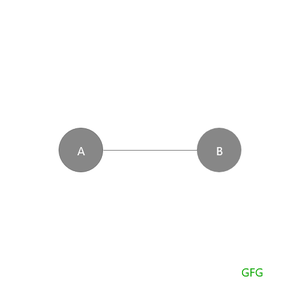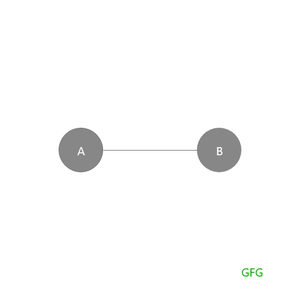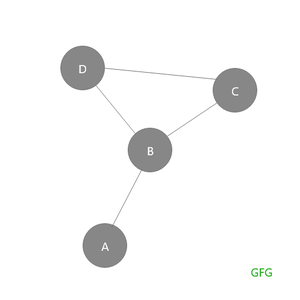图中的悬垂顶点、非悬垂顶点、悬垂边和非悬垂边
先决条件:握手定理。
吊坠顶点
设G是一个图,当且仅当v的度数为 1时, G的顶点v称为悬垂顶点。换句话说,悬垂顶点是度数为 1的顶点,也称为悬垂顶点。
Note: Degree = number of edges connected to a vertex
在树的情况下,悬垂的顶点被称为终端节点或叶节点,或叶,因为它只有1度。请记住,叶节点只有 1 度,因此在树的情况下,下垂顶点称为叶节点。
示例:在给定的图中A和B是悬垂顶点,因为它们每个的度数为1 。

图 1.0
让我们以这个例子来打印图中所有的悬垂顶点。
C++
// C++ program for the above approach
#include
using namespace std;
// Function to print all the pendant
// vertices
void printPendantVertices(map > graph)
{
// All the vectors which contain only 1
// vertex i.e, size 1 has only 1 edge
// hence a pendant vertex.
for (auto x : graph) {
if (x.second.size() == 1) {
cout << x.first << " ";
}
}
}
// Driver Code
int main()
{
map > graph;
graph['A'].push_back('B');
graph['B'].push_back('A');
graph['C'].push_back('B');
graph['B'].push_back('C');
printPendantVertices(graph);
return 0;
} Javascript
A C 非悬垂顶点
非悬垂顶点是度数不是1的顶点。在树的情况下,非悬垂顶点是非叶节点,因为它没有度数1 (叶节点的度数为1 )。
示例:在给定的图中A和C是悬垂顶点,因为A和C的度数为1 , B 是非悬垂顶点,因为它包含的度数不是1 ,即2 。

图 2.0
吊坠边缘
当且仅当其顶点之一是悬垂顶点时,图的边被称为悬垂边。
示例:在给定的图中AB是一个悬垂边,因为它包含悬垂顶点作为其顶点之一。

图 3.0
非吊边
如果图的边不包含作为其顶点之一的悬垂顶点,则称该边为非悬垂边。
示例:在给定的图中AB是一个悬垂边,因为它具有悬垂顶点 (A) 作为其顶点之一。 BD、BC、DC是非悬垂顶点。

图 4.0
例子:
让我们看一些基于上述主题的示例:
Q1。假设一棵树 T 有 2 个度数为 2 的顶点、4 个度数为 3 的顶点和 3 个度数为 4 的顶点。求 T 中的悬垂顶点数。
Finding number pendant vertices is nothing but finding the number of leaf nodes.
Let’s use the Handshaking Theorem formula
Sum of all degrees = 2 * (Sum of Edges)
(2 vertices) * (2 degrees) + (4 vertices) * (3 degrees) + (3 vertices) * (4 degrees) + (k vertices) * (1 degree) = (2 * edges)
where
k is pendant vertices or leaf nodes which have degree 1
e is total number of edges in the tree
2*2 + 4*3 + 3*4 + k*1 = 2*e ——-(1)
remember : number of edges = number of vertices – 1
e=(2+4+3+k)-1
e=9+k-1
e=8+k ——-(2)
putting equation 2 in 1 gives
4 + 12 + 12 + k = 2(8+k)
28 + k = 16 + 2k
-2k + k = 16 – 28
-k = -12
k = 12
so total number of pendant vertices are 12
Q2。如果一棵树 T 有 4 个 2 度的顶点、1 个 3 度的顶点和 2 个 4 度的顶点和 1 个 5 度的顶点。求 T 中的下垂顶点数。
Finding number pendant vertices is nothing but finding the number of leaf nodes.
Let’s use the Handshaking Theorem formula
Sum of all degrees = 2 * (Sum of Edges)
(4 vertices)*(2 degrees) + (1 vertex)*(3 degrees) + (2 vertices)*(4 degrees) + (1 vertex)*(5 degree) + (k vertices)*(1 degree) = (2 * edges)
where
k is pendant vertices or leaf nodes which have degree 1
e is total number of edges in the tree
4*2 + 1*3 + 2*4 + 1*5 + k*1 = 2*e ——-(1)
remember number of edges = number of vertices – 1
e=(4+1+2+1+k)-1
e=8+k-1
e=7+k ——-(2)
putting equation 2 in 1 gives
8 + 3 + 8 + 5 + k = 2(7+k)
24 + k = 14 + 2k
-2k + k = 14 – 24
-k = -10
k = 10
so total number of pendant vertices are 10